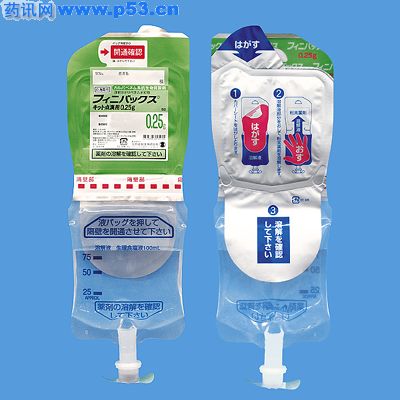|
【药品名称】多尼培南
【通 用 名】Doripenem
【其他名称】Doripenem、Doribax、Finibax。
多尼培南是由日本盐野义公司研发的β-内酰胺类抗生素中碳青霉烯类抗生素,强生公司从日本盐野义公司获得了该药的开发上市权。2005年9月多培尼南首次在日本上市,商品名为Finibax。2007年10月,美国FDA批准该药注射剂用于临床治疗复杂性腹内感染与复杂性尿道感染。
多尼培南的作用机制与其他β-内酰胺类抗生素相同,主要是与细菌青霉素结合蛋白(peni-cillin binding proteins,PBPs)结合,抑制细菌细胞壁的合成。本品抗菌谱广,对各种需氧性、厌氧性G十和G一菌都有很强的抗菌活性。并且对绝大多数β-内酰胺酶稳定强。
本品为静脉注射剂,成人每次推荐剂量为0.25 g,30-60 min内静脉注射,剂量的大小可根据患者年龄及症状轻重适当增减,但每次最多不超过0.5 g,每天最大剂量不超过1.5 g。本品在人体内稳定,不受人脱氢肽酶的影响,静脉注射125mg的半衰期(T l/2)为0.85 h,其代谢产物为β-内酰胺环水解开环物,主要经尿液排除,24 h尿中药物回收率为75%,微量随粪便排出,其药代动力学特点与美罗培南相似,不受大剂量给药影响。本晶每天给药250-l000毫克(分一次、两次或三次给药),对复杂性尿路感染和慢性呼吸道感染的有效治疗率为93.8%~95.2%,细菌清除率为87.5%~98.2%,显示出良好的抗菌作用。多尼培南临床主要应用于呼吸道感染、尿路感染、外科感染以及妇科产科感染。不良反应有腹泻、皮疹等。
【临床应用】
1. 美国FDA 批准适应证:
(1) 用于多种细菌引起的复杂性腹腔内感染。
(2) 用于多种细菌引起的复杂性泌尿道感染( 包括肾盂肾炎)。
2. 日本厚生省批准适应证:
(1) 腹膜炎、腹腔内脓疡、胆囊炎、胆管炎。
(2) 复杂性膀胱炎、肾盂肾炎、急性或慢性前列腺炎、副睾丸炎、子宫内感染、子宫附件炎。
(3) 咽头炎、喉头炎、扁桃体炎( 含扁桃周围炎、扁桃周围脓肿)、肺炎、肺脓疡、脓胸、慢性呼吸系统病变的二次感染。
(4) 外伤、烧烫伤及手术创伤等的二次感染,深层性皮肤感染( 淋巴管炎、淋巴结炎)。
(5) 眼窝感染、角膜炎( 含角膜溃疡)、眼内炎( 含全眼球炎)、中耳炎。
(6) 败血症、感染性心内膜炎、骨髄炎、关节炎、腭骨周边的蜂巢炎、腭炎。
【注意事项】
1. 交叉过敏 β- 内酰胺抗生素类之间有交叉过敏。
2. 禁忌证 对本药或对其他β- 内酰胺类抗生素过敏者。
3. 慎用 哺乳妇女。
4. 药物对儿童的影响 儿童用药的安全性和有效性尚未确立。
5. 药物对老人的影响 本药在老年人中的暴露量增加,且老年人易出现肾功能减退或肾前性氮血症,不良反应的发生风险高于其他人群。
6. 药物对妊娠的影响 孕妇用药尚无充分、良好的对照研究资料,孕妇仅在确有必要时方可使用。美国食品药品管理局对本药的妊娠安全性分级为B 级。
7. 药物对哺乳的影响 尚不明确本药是否分泌入乳汁中,哺乳妇女应慎用。
8. 用药前后及用药时应当检查或监测 老年患者和中至重度肾功能损害者应定期检查肾功能。
【不良反应】
可见过敏反应,史-约综合征(Stevens-Johnson Syndrome)、中毒性表皮坏死松解症、间质性肺炎、癫痫发作。此外,临床试验中出现以下不良反应:
1. 心血管系统 常见静脉炎。
2. 泌尿生殖系统 可见外阴真菌感染、肾损害、肾衰竭。
3. 神经系统 常见头痛。
4. 肝脏 可见丙氨酸氨基转移酶升高、天门冬氨酸氨基转移酶升高。
5. 胃肠道 常见恶心、腹泻,还可见口腔念珠菌病、艰难梭状芽孢杆菌相关的腹泻(CDAD)。
6. 血液 可见贫血。
7. 皮肤 常见皮疹,可见瘙痒、斑疹、丘疹、荨麻疹、过敏性皮炎和大疱性皮炎、红斑、多形性红斑。
8. 其他 可见耐药菌的出现。
【用法与用量】
成人 常规剂量
1. 美国FDA 批准用法用量:对伴发菌血症的患者,疗程可持续14 日。(1) 复杂性腹腔内感染:一次500mg,每8 小时1 次,1 小时输注完,5~14 日为一疗程。(2) 复杂性泌尿道感染( 包括肾盂肾炎) : 一次500mg,每8 小时1 次,1 小时输注完,10 日为一疗程。
2. 日本厚生省批准用法用量:一次250mg,一日2~3 次,滴注30~60 分钟,根据年龄、症状适当增减,最大量为一次500mg,一日1.5g。
肾功能不全时剂量
肾功能不全时给药剂量表
肌酐清除率(mL/min) 剂量
> 50 无需调整剂量
≥ 30 或≤ 50 一次250mg,1 次/8h
> 10 或< 30 一次250mg,1 次/12h
老年人剂量
肾功能损害的老年人应适当调整剂量,而肾功能正常的老年患者,不推荐进行剂量调整。
【制剂与规格】注射用多尼培南 (1)250mg。(2)500mg。贮法:25℃(15~30℃ ) 下保存。


INDICATIONS
DORIBAX® is indicated as a single agent in adults ( >18 years of age) for the treatment of:
- Complicated intra-abdominal infections caused by susceptible strains of E coli ,K pneumoniae , P aeruginosa , B caccae , B fragilis , B thetaiotaomicron , B uniformis ,B vulgatus , S intermedius , S constellatus , or P micros;
- Complicated urinary tract infections, including pyelonephritis caused by susceptible strains of E coli, including cases with concurrent bacteremia, K pneumoniae, P mirabilis, P aeruginosa, or A baumannii.
To reduce the development of drug-resistant bacteria and maintain the effectiveness of DORIBAX® and other antibacterial drugs, DORIBAX® should be used only to treat infections that are proven or strongly suspected to be caused by susceptible bacteria. When culture and susceptibility information are available, they should be considered in selecting and modifying antibacterial therapy. In the absence of such data, local epidemiology and susceptibility patterns may contribute to the empiric selection of therapy.
IMPORTANT SAFETY INFORMATION
DORIBAX® is contraindicated in patients with known serious hypersensitivity to doripenem or other carbapenems, or in patients who have demonstrated anaphylactic reactions to beta lactams.
Serious and occasionally fatal hypersensitivity (anaphylactic) and serious skin reactions have been reported in patients receiving beta-lactam antibiotics. These reactions are more likely to occur in individuals with a history of sensitivity to multiple allergens.
If an allergic reaction to DORIBAX® occurs, discontinue the drug. Serious acute anaphylactic reactions require emergency treatment with epinephrine and other emergency measures, including oxygen, IV fluids, IV antihistamines, corticosteroids, pressor amines and airway management, as clinically indicated.
Due to a drug interaction, patients with seizure disorders controlled with valproic acid or sodium valproate will be at an increased risk for breakthrough seizures when treated with DORIBAX® concomitantly. In some reports, increasing the dose of valproic acid or sodium valproate did not result in increased valproic acid serum concentrations. Alternative antibacterial therapies should be considered for patients receiving valproic acid or sodium valproate. If administration of DORIBAX® is necessary, supplemental anti-convulsant therapy should be considered.
Clostridium difficile-associated diarrhea (CDAD) has been reported with nearly all antibacterial agents and may range in severity from mild diarrhea to fatal colitis. CDAD must be considered in all patients who present with diarrhea following antibiotic use. Careful medical history is necessary since CDAD has been reported to occur over 2 months after administration of antibacterial agents. If CDAD is suspected or confirmed, ongoing antibiotic use not directed against C difficile may need to be discontinued.
When doripenem has been used investigationally via inhalation, pneumonitis has occurred. DORIBAX® should not be administered by this route.
Safety and effectiveness in pediatric patients have not been established.
The most common adverse reactions ( >5%) observed in clinical trials were headache, nausea, diarrhea, rash, and phlebitis.
Please click here for full Prescribing Information for DORIBAX®.

DORIBAX
Generic Name for DORIBAX
Doripenem (as monohydrate) 500mg/vial; pwd; for IV infusion after constitution and dilution; preservative-free.
Legal Classification:
Rx
Pharmacological Class for DORIBAX
Carbapenem.
Manufacturer of DORIBAX
Ortho-McNeil Pharmaceuticals, Inc.
Indications for DORIBAX
Susceptible complicated intra-abdominal and complicated urinary tract infections (including pyelonephritis).
Adult dose for DORIBAX
Give by IV infusion over 1 hr; may switch to oral antibiotics after 3 days. ≥18yrs (CrCl >50mL/min): Intra-abdominal: 500mg every 8 hrs for 5–14 days. UTI, pyelonephritis: 500mg every 8 hrs for 10–14 days. CrCl 30–50mL/min: 250mg every 8 hrs; CrCl>10–<30mL/min: 250mg every 12 hrs.
Children's dosing for DORIBAX
<18yrs: not recommended.
Contraindications for DORIBAX
Beta-lactam allergy.
Warnings/Precautions for DORIBAX
Pregnancy (Cat.B). Nursing mothers.
Interactions for DORIBAX
Antagonizes valproic acid (monitor valproate frequently). Potentiated by probenecid (not recommended).
Adverse Reactions for DORIBAX
Headache, nausea, diarrhea (may be serious; evaluate if occurs), rash, phlebitis, anemia, hypersensitivity reactions.
How is DORIBAX supplied
Single-use vials—10 | 




